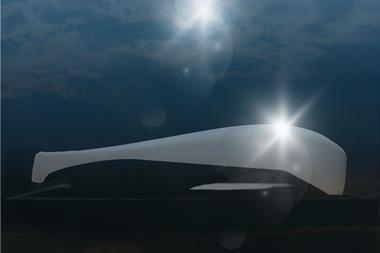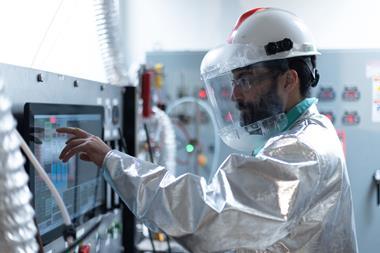With so many hard part machining applications in the automotive sector, keeping up with the latest manufacturing technologies is imperative.
Around 55% of applications for PCBN (polycrystalline cubic boron nitride) cutting tools are in the automotive sector – gears, shafts, CV joints, injector nozzles, bearings, extrusion dies and pressure rolls, to name but a few. As a result, there is clear market demand for stable and predictable cutting tool solutions for hard turning materials over 45 HRc at temperatures approaching 1,000°C.
PCBN is produced by ultra-high-pressure sintering at temperatures up to 1,500°C for the carefully controlled mix of micron-sized crystals of synthesised CBN with a special high purity bonding agent of metallic or ceramic matrix. This is bonded integrally to a tungsten carbide substrate that ensures chemical stability and achieves the closest hardness of a cutting material to synthetic diamond. PCBN composites are also said to provide far greater levels of resistance to deformation and wear than ceramic cutting tools.
Sumitomo Electric Hardmetal claimed the ‘world first’ in 1977 for the development of PCBN on a commercial basis under its Sumiboron trade name, focusing on the turning of hardened steel to replace the grinding process.
 Today, the latest PCBN turning inserts from Sumitomo Electric are designated Sumiboron BN1000, BN2000, BN350 and BNC300. Sumiboron BN1000 and BN2000 are both uncoated grades with a high purity ceramic binder giving high fracture and wear resistance for extended tool life on a variety of hardened steels. Meanwhile, BNC300 (C designates a coated grade) and BN350 are specifically for gaining maximum advantage from interrupted cutting applications, such as splined shafts, where resistance to chipping is paramount.
Today, the latest PCBN turning inserts from Sumitomo Electric are designated Sumiboron BN1000, BN2000, BN350 and BNC300. Sumiboron BN1000 and BN2000 are both uncoated grades with a high purity ceramic binder giving high fracture and wear resistance for extended tool life on a variety of hardened steels. Meanwhile, BNC300 (C designates a coated grade) and BN350 are specifically for gaining maximum advantage from interrupted cutting applications, such as splined shafts, where resistance to chipping is paramount.
Sumiboron uncoated BN1000 is most suitable for higher speed machining and light interrupted cuts due to its high purity TiCN ceramic binder for use at cutting speeds between 150 and 280m/min, says the company. Depth-of-cut should be up to 0.2mm with feed per rev up to 0.15mm.
In recent trails, a Sumiboron BN1000 insert running at 200m/min, 0.1mm/rev feed and 0.1mm depth of cut on 15 CrMo5 round steel bar (58-62 HRc) achieved a total cutting length of almost 4km, it says. Furthermore, over that distance, size variation in the batch was just 4μm. A competitor CBN insert over the same distance had a progressive size variation of 0.1mm but it passed the Sumiboron point of maximum wear at just 2.3km – a fall-off by over 70% in consistency of size claims Sumitomo.
In another cutting trial, Sumiboron BN350 was pitched against the company’s previous uncoated PCDN grade (BN300) in the turning of a hardened gear shaft in SCr420H steel (58-62 HRc). Machining at a speed of 125m/min with a feed of 0.15mm/rev and 0.3mm depth of cut (without coolant), the number of pieces produced more than doubled from 52 to 125, says the company.
Seco Tools also has a new spin on hard turning. Using the latest Secomax CBN060K and a solid PCBN format, Seco says it is possible to plunge turn (as opposed to conventional hard turn) a range of case-hardened steel components in a fraction of the time. Plunging essentially uses a significant part of the cutting edge length to generate the machined surface. The concept is not new, since it has been used very successfully in the plunging of valve seats in engine cylinder heads for many years, but is now applied to turning.
The process relies on a number of key factors. Insert edge quality is important to achieve good surface finish and maximise tool life, but it is also necessary to increase cutting speeds and reduce feed rates to lower cutting forces and ensure dimensional accuracy. In the process, the insert is allowed to dwell at the base of the cut for three or four revolutions. To avoid the cutting edge profile affecting the surface finish, a small axial movement is made.
In gear turning, plunging is now a commonly preferred method used for machining gear faces and synchromesh tapers. The longest edge machined by plunging is around 16mm, says Seco.
Another hard turning application, hard grooving, requires equal levels of innovation, something claimed to be facilitated by Mapal’s recently introduced VersaCut range. VersaCut tools use long-life inserts that are retained in the toolholder by a clamping jaw that presses them into a prismatic connection. Because of the large clamping force used, this arrangement provides the high stability needed for precision machining, but the design of the clamp also allows the inserts to be changed quickly and easily, says Mapal.
PCBN inserts for Mapal’s VersaCut range are available in four standard types to suit all common machining applications, including recessing, groove turning, thread cutting and parting-off. All inserts have the same connection shape and size, which means that only one type of toolholder is needed for grooving depths up to 5mm and grooving widths from 1.2 to 6mm.

Of course, machining hard materials is not all about turning operations. Grinding operations remain prevalent, particularly those that have demonstrated considerable levels of process evolution to deliver high volume throughput and cost savings. A case in point can be seen at the Devizes, UK facility of Cross Manufacturing, which uses double side-face grinding machines from Diskus Werke to help it produce automotive turbocharger sealing rings in annual volumes running into tens of millions.
By utilising two opposing wheels to simultaneously grind both sides of a workpiece, in a single operation, double-disc grinding removes equal amounts of material from both surfaces of the turbocharger sealing rings, which are made from a resilient wrought alloy capable of withstanding operational temperatures of up to 1,000°C.
Double-disc grinding is now established as the most advantageous method for the grinding of parts such as piston rings. High volume or automated double-disc grinding also provides cost-effective thickness sizing for small parts such as fine blanked stamped, die cast and sintered metal parts, or bearing rings and rollers.
An alternative approach to this might be hard milling, but probably not in the conventional sense. With this in mind, the recently introduced Tongtai T51-USA ultrasoundassisted machining centre offers an innovative approach to the machining of hard materials, says the company.
 The Diskus DDSXR
The Diskus DDSXR
concept exploited by
Cross Manufacturing
Cross Manufacturing’s latest acquisition is a Diskus DDS 457 XR through-feed grinder that is capable of the mass production of more than 7,000 parts per hour. The new machine features an FEM-designed machine base giving high axial and bending rigidity. Two vertical grinding motor-spindles, mounted on pre-loaded rolling rails, provide infi nitely variable grinding speeds of up to 63m/s and infi nitely variable grinding wheel in-feed.
The T51-USA uses ultrasound to machine hard metals such as mould steels. A high-speed rotary spindle (up to 24,000rpm) is partnered with a high frequency ultrasound generator that creates vibrations between 15 and 45 kHz with amplitude of just a few microns. Ultrasoundassisted machining is more commonly found on lathe and grinding machines but in highspeed milling, where small tool crossover paths and shallow depths of cut (up to 1mm) are applied, the process delivers improved surface finishes.
The T51-USA has axis strokes of 510, 400, 350mm, capacity for up to ten tools in its disc carousel and is capable of cutting feed rates up to 20m/min.





































